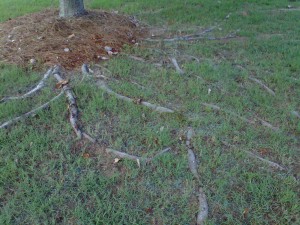Do’s and Don’t of Dealing with Surface Roots
Are you and your mower bouncing all over the place when you run over some areas of your lawn? Are surface roots of trees to blame? Depending what variety of trees you have, you may end up with some bumpy spots in your lawn. Some trees are genetically predisposed to having lots of surface roots. However most trees, especially later in their lives, will start to create these types of conditions.
In situations where soil erodes and/or is compacted because of the high amount of clay in the soil, you’ll also see more and more roots at the surface. Tree roots aren’t only seeking moisture and nutrients in the soil, they’re also in search of oxygen. This means the majority of tree roots will be found in the top 12″ of soil. As the tree ages and its trunk increases so does the diameter of the roots. This may mean that finger-thick sized root that stretched across your lawn has now grown as thick as your arm! This means it’s visible above the surface now.
If you have areas in your lawn that are being invaded by tree roots, follow these recommendations:
 DON’T add soil
DON’T add soil
If a tree is seeking oxygen in soil for it’s survival, adding soil on top of roots is counterproductive. Trees are growing these roots to survive, so it’s important to not do anything detrimental to these roots. Doing otherwise will end up causing significant stress to the tree, and could even cause a premature death. Adding soil will only suffocate roots. They will begin to rot and also will stimulate a root system growing and girdling the tree.
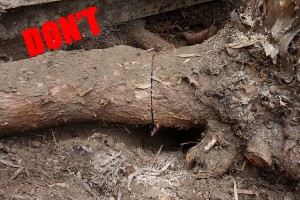 DON’T cut roots
DON’T cut roots
If you cut roots off you are reducing the tree’s ability to get its needed oxygen, water, and nutrients. Additionally, you are introducing an injury at your cut point that will attract the fungi. When you do that, these fungi begin to rot the root itself. Remember, the root you’re removing is the beginning of the line in a very long section of smaller, fibrous roots. You’re actually removing a lot more of the root system than you may think.
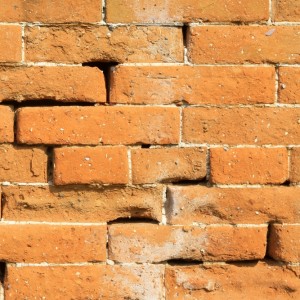 DON’T install a raised planting bed
DON’T install a raised planting bed
If you install a raised planting bed around a tree with or without a wall it’s a bad idea. The tree will then essentially be planted below the proper grade level. This practice leads to trunk decay and girdling roots. Plus, as roots start to grow in the new soil to find oxygen (because the lower ones will start to decay) they will eventually start pushing against any retaining walls you may install, causing them to lean and fall over.
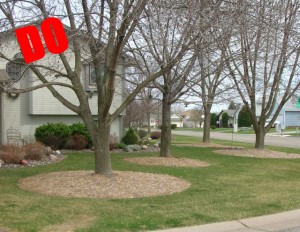 DO expand mulch beds
DO expand mulch beds
Most trees should have a thin layer of mulch around where the trunk meets the ground to keep a buffer from mower and string trimmer damage. As your tree grows, you may need to increase the radius of these areas. Cut out what grass you can. Try to avoid spraying herbicide to kill off the grass where a lot of surface roots are present as this could potentially damage the tree if enough material gets on the roots. If grass starts to sprout out of your new mulch, you can safely spray it at that later time.
If these areas are drastically increased and seem out of place, adding a few shade-loving perennials underneath will help these areas to look intentional. Just don’t overdo it. It will be difficult to dig in these areas because of the presence of roots and you also don’t want to create a lot of competition for nutrients, water, and oxygen. Expanded beds also means less lawn areas for you to mow each week which may be an added bonus for those of you who don’t enjoy that part of property maintenance.
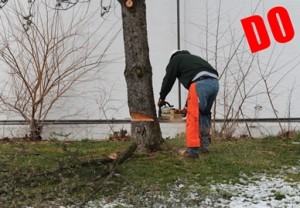 DO remove the tree
DO remove the tree
If this is a battle you just can’t see winning with expanding mulch beds and your pain of mowing over those roots every week is significant enough, removing trees may be your best option. Cutting down the tree, grinding out the surface roots, and re-grading the area with soil and seed will give you an area easier to maintain with mowing. Plus maintaining a small lawn area will cost less than the maintenance of a tree in the long run. If the location is one you’ll want to plant trees again, do your research to find a tree that isn’t one that will grow a lot of surface roots. Using a knowledgeable landscape designer that understands what tree is best can help you plan for a less-frustrating future with your new tree.
If managing tree roots in your lawn seems a task you don’t want to attempt or need help accomplishing this, we would welcome the opportunity to give you a free consultation. We can discuss the options available and come up with a solution that is best.

